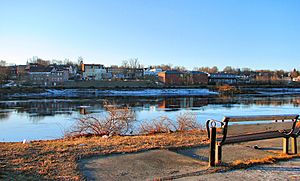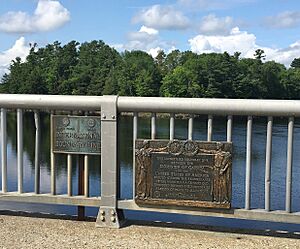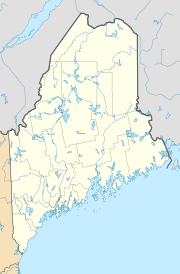Calais, Maine facts for kids
Quick facts for kids
Calais, Maine
|
|
|---|---|
|
City
|
|
 |
|
| Country | United States |
| State | Maine |
| County | Washington |
| Settled | 1779 |
| Incorporated | June 16, 1809 |
| Area | |
| • Total | 40.11 sq mi (103.88 km2) |
| • Land | 34.32 sq mi (88.90 km2) |
| • Water | 5.79 sq mi (14.98 km2) |
| Elevation | 43 ft (13 m) |
| Population
(2020)
|
|
| • Total | 3,079 |
| • Density | 89.71/sq mi (34.64/km2) |
| Time zone | UTC-5 (Eastern (EST)) |
| • Summer (DST) | UTC-4 (EDT) |
| ZIP code |
04619
|
| Area code(s) | 207 |
| FIPS code | 23-09585 |
| GNIS feature ID | 0563341 |
Calais (say "CAL-iss") is a city in Washington County, Maine, United States. It's located right on the border with Canada. In 2020, about 3,079 people lived there. This makes Calais the biggest town in Washington County by population.
Calais is an important place for shopping and business in eastern Washington County. It's also a key shopping spot for people from Charlotte County, New Brunswick in Canada. Many businesses in Calais focus on retail, services, and construction.
Contents
A Look Back: Calais History
Early Days and First Settlers
For thousands of years, native people lived in this area. The Passamaquoddy people, who spoke an Algonquian language, were here when Europeans first arrived.
The St. Croix River area was first explored by the French explorer Samuel de Champlain in 1604. He and his crew spent a winter on St. Croix Island. The first permanent settler was Daniel Hill. He came from Jonesboro in 1779 during the American Revolutionary War. In 1782, he and other settlers built the first sawmill here.
How Calais Got Its Name
On June 16, 1809, the area was officially named Calais. It was named after Calais, France. This was done to honor France for helping the United States during the American Revolutionary War.
The river was very important for early industries. It provided water power for many mills. These included sawmills, mills for making clapboard and shingles, and grain mills. There were also factories that made axes, shoes, and bricks.
A Special Friendship with Canada
Calais has a very close and long-lasting friendship with its Canadian neighbor, St. Stephen, New Brunswick. A great example of this friendship happened during the War of 1812. The British military gave St. Stephen a lot of gunpowder to protect against the American "enemy" in Calais. But the leaders of St. Stephen actually gave that gunpowder to Calais! They used it for their Fourth of July celebrations.
Railroads and Growth
Calais was home to the very first railroad built in Maine. It was called the Calais Railroad. It started in 1832. This railroad helped move lumber from mills to the river. Later, it became part of the St. Croix & Penobscot Railroad.
Calais officially became a city on August 24, 1850.
Historic Buildings and Places
The Calais Free Library is a beautiful building. It was designed by an architect from Boston and opened on July 4, 1893. This building is listed on the National Register of Historic Places.
Many other places in Calais are also listed on the National Register of Historic Places. These include:
- Calais Historic District
- Calais Residential Historic District
- Devils Head Site
- Gilmore House
- Thomas Hamilton House
- Hinckley Hill Historic District
- Holmes Cottage
- Dr. Job Holmes House
- Theodore Jellison House
- Pike's Mile Markers
- St. Anne's Episcopal Church
- George Washburn House
- Whitlocks Mill Light
Calais Today: Geography and Nature
Calais is located where the St. Croix River meets the ocean tides. The city covers about 40 square miles (103.88 square kilometers). Most of this is land, with some water.
The City of Calais recently bought a special place called Devil's Head. This area has 318 acres (128.7 hectares) of land. It also has a mile of riverfront along the St. Croix River. Devil's Head features a tall granite cliff, a sandy beach, forests, and lots of wildlife. Trails for exploring were finished in 2003.
Calais is also the northern end of the East Coast Greenway. This is a long trail that goes all the way down to Key West, Florida.
Who Lives in Calais?
| Historical population | |||
|---|---|---|---|
| Census | Pop. | %± | |
| 1810 | 372 | — | |
| 1820 | 418 | 12.4% | |
| 1830 | 1,686 | 303.3% | |
| 1840 | 2,934 | 74.0% | |
| 1850 | 4,749 | 61.9% | |
| 1860 | 5,621 | 18.4% | |
| 1870 | 5,944 | 5.7% | |
| 1880 | 6,173 | 3.9% | |
| 1890 | 7,290 | 18.1% | |
| 1900 | 7,655 | 5.0% | |
| 1910 | 6,116 | −20.1% | |
| 1920 | 6,084 | −0.5% | |
| 1930 | 5,470 | −10.1% | |
| 1940 | 5,161 | −5.6% | |
| 1950 | 4,589 | −11.1% | |
| 1960 | 4,223 | −8.0% | |
| 1970 | 4,044 | −4.2% | |
| 1980 | 4,262 | 5.4% | |
| 1990 | 3,963 | −7.0% | |
| 2000 | 3,447 | −13.0% | |
| 2010 | 3,123 | −9.4% | |
| 2020 | 3,079 | −1.4% | |
| sources: | |||
In 2010, there were 3,123 people living in Calais. Most people were White (95.5%). About 1.3% were Native American. The average age in Calais was 45.3 years old.
Learning in Calais: Schools and Colleges
Public Schools
Calais has schools for all ages, from elementary to high school. There's also a technical school.
- Calais High School
- St. Croix Regional Technical School
Higher Education
For students who want to continue their education, Calais has a two-year community college.
- Washington County Community College
The closest four-year university is in Machias, Maine.
Getting Around and Staying Healthy
Transportation
Calais is a hub for travel. It's where two main roads meet: U.S. 1 (which runs along the East Coast) and Route 9 (which crosses Maine).
Since 2012, Calais also has direct access to New Brunswick Route 1 in Canada. This is a major highway that connects to other parts of Canada. You can also take a bus from Calais to Bangor.
Healthcare
Calais Regional Hospital (CRH) is an important hospital for the area. It has 15 beds for acute care and 10 "swing" beds. It also has an emergency room that's open 24 hours a day. The hospital serves about 14,000 people in northeastern Washington County. CRH is the biggest employer in Calais, with over 200 staff members.
- Calais Regional Hospital
Famous People from Calais
Many interesting people have come from Calais, including:
- Nehemiah Abbott, a U.S. congressman
- Lyn Mikel Brown, an academic and author
- Ron Corning, a television anchorman
- Andrea Gibson, a spoken word artist and poet
- Frederick A. Pike, a U.S. congressman
- Tim Sample, a humorist
- Harriet Prescott Spofford, an author
Crossing the Border to Canada

Calais has three ways to cross the border into St. Stephen, New Brunswick, Canada. These are the Ferry Point International Bridge, the Milltown International Bridge, and the International Avenue Bridge.
The International Avenue Bridge opened in 2009. It was built to help with traffic and make border crossings smoother. This bridge is mainly for commercial trucks, but cars and buses can use it too. The other two bridges are still used for cars and people walking.
The new border facility is very modern. It uses special equipment to check vehicles quickly and safely. It was also built using "green" building practices. This means it uses recycled materials and saves energy and water.
Cool Places to Visit in Calais
See also
 In Spanish: Calais (Maine) para niños
In Spanish: Calais (Maine) para niños







